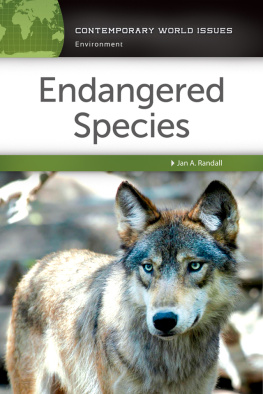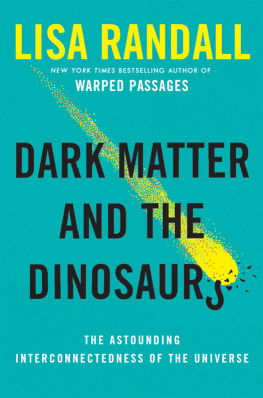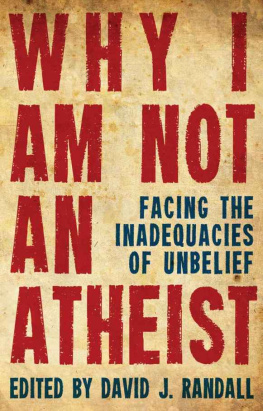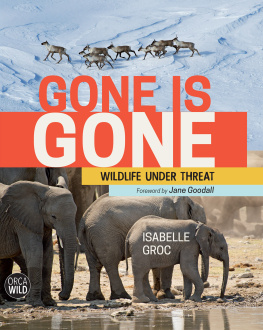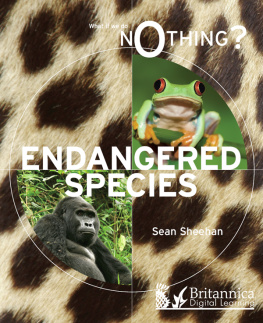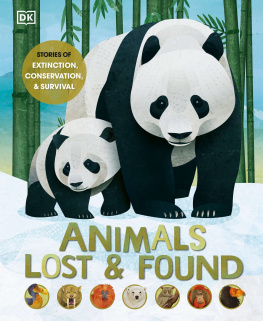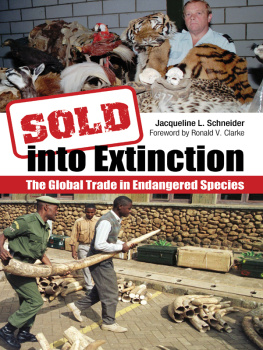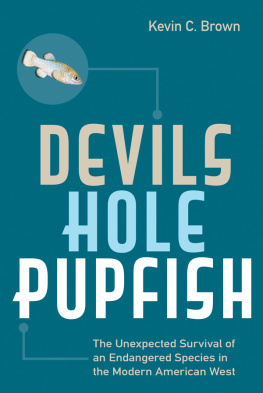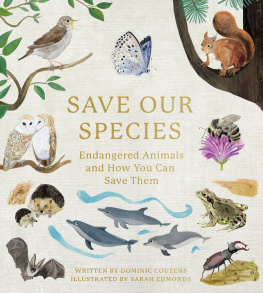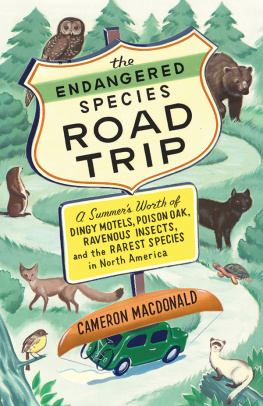Endangered Species
Recent Titles in the Contemporary World Issues Series
Student Debt: A Reference Handbook
William Elliott III and Melinda K. Lewis
Food Safety: A Reference Handbook, third edition
Nina E. Redman and Michele Morrone
Human Trafficking: A Reference Handbook
Alexis A. Aronowitz
Social Media: A Reference Handbook
Kelli S. Burns
Prisons in the United States: A Reference Handbook
Cyndi Banks
Substance Abuse: A Reference Handbook, second edition
David E. Newton
Campus Sexual Assault: A Reference Handbook
Alison E. Hatch
Sex and Gender: A Reference Handbook
David E. Newton
The Death Penalty: A Reference Handbook
Joseph A. Melusky and Keith A. Pesto
The American Political Party System: A Reference Handbook
Michael C. LeMay
Steroids and Doping in Sports: A Reference Handbook, second edition
David E. Newton
Religious Freedom in America: A Reference Handbook
Michael C. LeMay
Books in the Contemporary World Issues series address vital issues in todays society such as genetic engineering, pollution, and biodiversity. Written by professional writers, scholars, and nonacademic experts, these books are authoritative, clearly written, up-to-date, and objective. They provide a good starting point for research by high school and college students, scholars, and general readers as well as by legislators, businesspeople, activists, and others.
Each book, carefully organized and easy to use, contains an overview of the subject, a detailed chronology, biographical sketches, facts and data and/or documents and other primary source material, a forum of authoritative perspective essays, annotated lists of print and nonprint resources, and an index.
Readers of books in the Contemporary World Issues series will find the information they need in order to have a better understanding of the social, political, environmental, and economic issues facing the world today.
Contemporary World Issues
Endangered Species
A REFERENCE HANDBOOK
Jan A. Randall
Copyright 2018 by ABC-CLIO, LLC
All rights reserved. No part of this publication may be reproduced, stored in a retrieval system, or transmitted, in any form or by any means, electronic, mechanical, photocopying, recording, or otherwise, except for the inclusion of brief quotations in a review, without prior permission in writing from the publisher.
Library of Congress Cataloging-in-Publication Data
Names: Randall, Jan A., author.
Title: Endangered species : a reference handbook / Jan A. Randall.
Description: Santa Barbara, California : ABC-CLIO, 2018. | Series: Contemporary world issues | Includes bibliographical references and index.
Identifiers: LCCN 2017035770 (print) | LCCN 2017054333 (ebook) | ISBN 9781440849008 (ebook) | ISBN 9781440848995 (alk. paper)
Subjects: LCSH: Endangered species.
Classification: LCC QH75 (ebook) | LCC QH75 .R36 2018 (print) | DDC 578.68dc23
LC record available at https://lccn.loc.gov/2017035770
ISBN: 978-1-4408-4899-5 (print)
978-1-4408-4900-8 (ebook)
22 21 20 19 18 1 2 3 4 5
This book is also available as an eBook.
ABC-CLIO
An Imprint of ABC-CLIO, LLC
ABC-CLIO, LLC
130 Cremona Drive, P.O. Box 1911
Santa Barbara, California 93116-1911
www.abc-clio.com
This book is printed on acid-free paper 
Manufactured in the United States of America
To by husband Bruce and all the species fighting for survival.
Contents
by Camille Parmesan
by Tom Lovejoy
by Suzanne Asha Stone
by Brock Evans
by Mark Rockwell
by Dave Stalling
by Michael Lehnert
by Douglas Trent
by C. Sarah Cohen
The decline in biodiversity, the amazing variety of plants, animals, and microorganisms bound together in a web of life, should be a major concern for anyone who inhabits planet Earth. In addition to the aesthetic value and enjoyment of natures diversity and beauty, a healthy and diverse environment is also one of human survival. Biodiversity provides the natural services on which humans depend: pollination, medicine, wood products, food, clean water and air, nutrient storage and cycling, soil formation and protection, climate stability, and recovery from unpredictable events.
A manifestation of biodiversity loss is the continuous decline of species, and in some cases even species declared threatened and endangered are losing ground. Elephants and rhinoceros killed for their tusks and horns are only one example of how overexploitation continues to destroy species, despite efforts to protect them. Amphibian, bat, and marine starfish populations are in rapid decline from the spread of new diseases. Coral is bleaching and dying from warming oceans. Agricultural practices, livestock farming, urban development, invasive species, pollution, human disturbance, transportation, and fossil fuel production continue to destroy habitats as human populations grow. Global climate change is a threat that will only grow larger in the future.
The loss in biodiversity has become so acute that scientists propose we are in a new age of mass extinctions. The rapid decline of populations of many species of plants and animals is driven by the uncontrolled expansion of human populations, which have quadrupled in the past century. In 1950, 2.5 billion people inhabited the Earth; today there are about 7 billion people, and a conservative estimate predicts that the human population will grow to 9 billion by 2045.
Scientists, naturalists, and environmentalists believe extensive efforts are required to prevent further extinctions of plants and animals. They consider the Endangered Species Act (ESA), passed in 1973 and signed by Republican Richard Nixon, the best line of defense to prevent species extinctions and diversity loss in the United States. Under the ESA, there has been steady progress in species recovery as measured by prevention of extinctions and the large number of threatened and endangered species recovering on the schedule set by the U.S. Fish and Wildlife Service. Scientists know that recovery of endangered species is a complicated process because at-risk species often have very small populations and inhabit areas of limited habitat. Recovery, therefore, can be a long process that may take decades.
The ESA has critics who wish to weaken it. Some private property owners, conservative politicians, the fossil fuel industry, developers, and representatives of commercial interests claim the ESA is not working, and they resent the regulations imposed by the act and claim too much interference by the federal government in private property decisions. As measured by the number of species declared recovered and delisted, they deem the act ineffective. There is concern about effects on property rights and the cost to industry and jobs.
The debate over the ESA and its effectiveness has been brewing for a long time and may be reaching a climax. Environmental skepticism is high in the Trump administration as demonstrated by appointments to the cabinet of avowed climate change skeptics and a Congress consisting of the same politicians who introduced dozens of amendments, bills, and riders aimed at weakening and stripping away provisions of the ESA in the last (114th) Congress. Efforts are being made to take powers away from the Environmental Protection Agency, and many of President Obamas executive orders affecting the environment are in the process of being reversed by new executive orders issued by Donald Trump. While environmentalists and their champions in Congress are committed to the prevention of a weakened ESA, those opposed to the law are equally determined.

